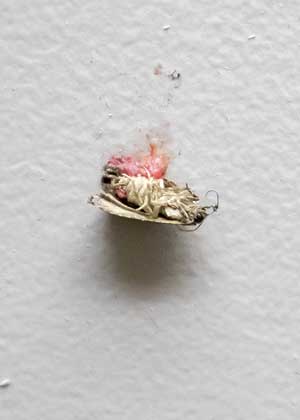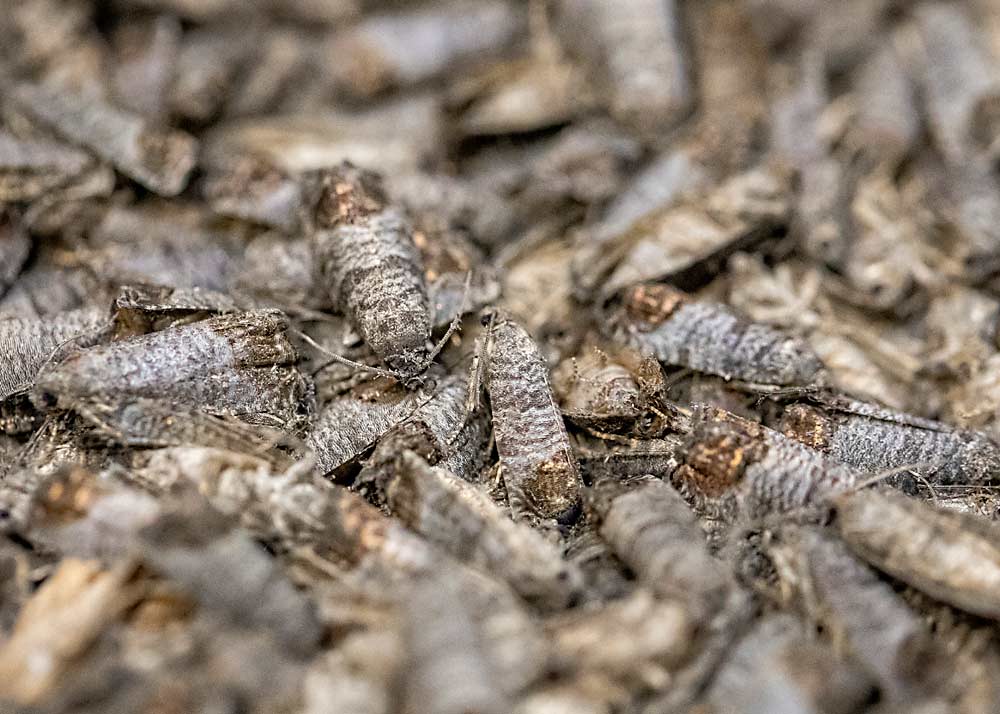
Olga Evans dumps containers of codling moths into cylindrical breeding chambers in the Okanagan-Kootenay Sterile Insect Release Program rearing facility in Osoyoos, British Columbia, in July 2018. The many rows of chambers, where female moths lay eggs, are where each generation of insects starts in the facility, which produces about 10 million sterile codling moths for agricultural use each week. (TJ Mullinax/Good Fruit Grower)
This factory’s widget is codling moths that can’t reproduce, and it cranks out more than 10 million of them each week.
With well-oiled efficiency and eye-popping scale, the Okanagan-Kootenay Sterile Insect Release Program rearing facility in Osoyoos, British Columbia, breeds, raises and irradiates the insects that have kept, for more than 25 years, the state’s orchards free of what otherwise would be a devastating pest.
Almost free, that is. From inception, the creators of the Sterile Insect Release Program intended to eradicate the codling moth from the apple and pear orchards of the Okanagan Valley. They came close.
Since 1991, the area has seen a 94-percent decrease in codling moth population and a 96-percent reduction in pesticide use, according to program statistics. Meanwhile, 98 percent of orchards in the southern region near the Washington border, the location of the first releases, met the economic target of less than 0.2 percent fruit damage from codling moth.
The facility’s manager, Scott Arthur, has noticed the reduction in insecticide use since he was a teenager growing up in the area. He recalls arriving at high school each morning with a car covered in insecticide residue.
The rearing facility, housed in a nondescript industrial complex overlooking the resort community of Osoyoos, produces the moths in a 42-day process.

A squished sterile codling moth on a wall. How can you tell if it’s sterile? The rearing facility feeds its moths red food dye in their diet, so growers can recognize them in the orchards. (TJ Mullinax/Good Fruit Grower)
Females lay eggs in cylinders lined with wax paper, which is torn off and suspended over cafeteria trays covered with moth “diet,” a mixture of sugar, flour, canola, vitamins, minerals and shredded craft paper to maintain its consistency. It looks like bran muffin mix.
The staff also mixes in a red dye that turns the moths’ insides bright pink. Outside the facility, the only way to tell a sterilized moth from a wild moth is to squish it.
Each sheet holds about 4,000 eggs. They hatch and the larvae spin down web-like strings to the trays, burrow into the diet and eat in humidity-controlled rearing rooms.
Next, they move to dark emergence rooms, where about 1,500 adults emerge from each tray and fly toward UV lights, where a vacuum system collects them.
Then, staff portions them, 800 each, into Petri dishes, which they stack in three columns of 15 and feed into a chamber that irradiates them with a cobalt source. Drivers then haul them to the scattered 8,700 acres of apple and pear orchards throughout the Okanagan Valley and disperse them with conveyer belts and fans hooked to ATVs. The bugs breed with the wild population and lay eggs that can’t hatch.
The staff retains about 4 percent of each brood to breed and start the next generation, occasionally topping off their gene pool with wild catches.

Thousands upon thousands of cold, mature sterile moths wait to be whisked away to orchards in British Columbia. (TJ Mullinax/Good Fruit Grower)
The whole process is funded by property taxes. Homeowners pay a share of their assessed value, while growers pay $140 per acre per year.
“It’s a funky business that we’re doing,” Arthur said. “But we just do it over and over and over.” •
—by Ross Courtney
Related: Breeding bugs to fly and die






Leave A Comment